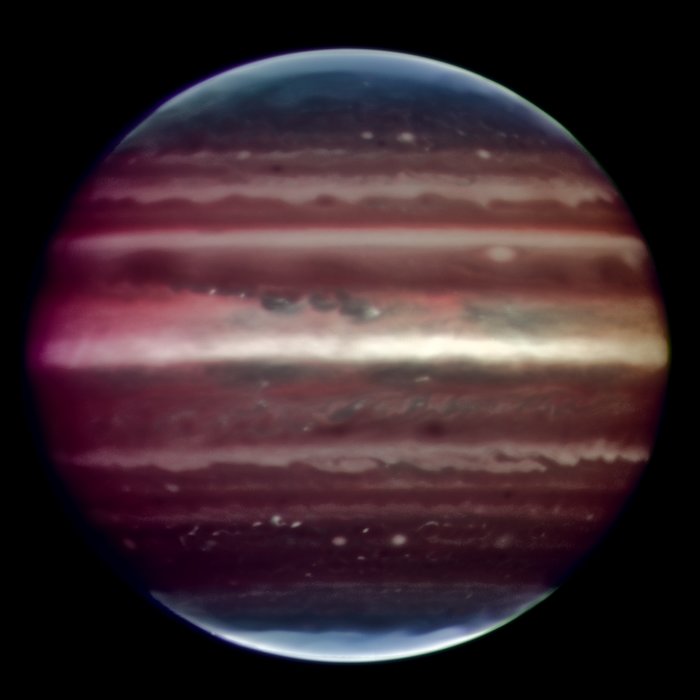Jupiter s'affine
Image étonnante de Jupiter prise en lumière infrarouge dans la nuit du 17 août 2008 avec le prototype d'instrument MAD (Multi-Conjugate Adaptive Optics Demonstrator) monté sur le Very Large Telescope de l'ESO. Cette photo en fausses couleurs est la combinaison d'une série d'images prises sur une période d'environ 20 minutes, à travers trois filtres différents (2, 2,14 et 2,16 microns). La netteté de l'image obtenue est d'environ 90 milli-arcsecondes d'arc sur l'ensemble du disque planétaire, un véritable record sur des images similaires prises depuis le sol. Cela correspond à voir des détails d'environ 300 km de large sur la surface de la planète géante. La grande tache rouge n'est pas visible sur cette image comme elle l'était de l'autre côté de la planète lors des observations. Les observations ont été faites dans les longueurs d'onde infrarouges où l'absorption due à l'hydrogène et au méthane est forte. Cela explique pourquoi les couleurs sont différentes de la façon dont nous voyons habituellement Jupiter dans le visible. Cette absorption signifie que la lumière ne peut être réfléchie que par les brumes de haute altitude, et non par les nuages plus profonds. Ces brumeux se trouvent dans la partie supérieure très stable de la troposphère de Jupiter, où les pressions sont comprises entre 0,15 et 0,3 bar. Le mélange est faible dans cette région stable, de sorte que les minuscules particules de brume sèche peuvent survivre pendant des jours, voire des années, selon leur taille et leur vitesse de chute. En outre, près des pôles de la planète, une brume stratosphérique plus élevée (régions bleu clair) est générée par les interactions avec les particules piégées dans le champ magnétique intense de Jupiter.
Crédit:ESO/F. Marchis, M. Wong, E. Marchetti, P. Amico, S. Tordo
À propos de l'image
| Identification: | eso0833a |
| Langage: | fr |
| Type: | Observation |
| Date de publication: | 2 octobre 2008 |
| Communiqués de presse en rapport: | eso2104, eso0833 |
| Taille: | 1730 x 1730 px |
À propos de l'objet
| Nom: | Jupiter |
| Type: | Solar System : Planet : Type : Gas Giant Solar System : Planet |
Fonds d'écran
Couleurs & filtres
| Domaine | Longueur d'onde | Télescope |
|---|---|---|
| Infrarouge Near-IR | 2.16 μm | Very Large Telescope ESO Multi-conjugate Adaptive optics Demonstrator (MAD) |
| Infrarouge Near-IR | 2.14 μm | Very Large Telescope ESO Multi-conjugate Adaptive optics Demonstrator (MAD) |
| Infrarouge Near-IR | 2.0 μm | Very Large Telescope ESO Multi-conjugate Adaptive optics Demonstrator (MAD) |
